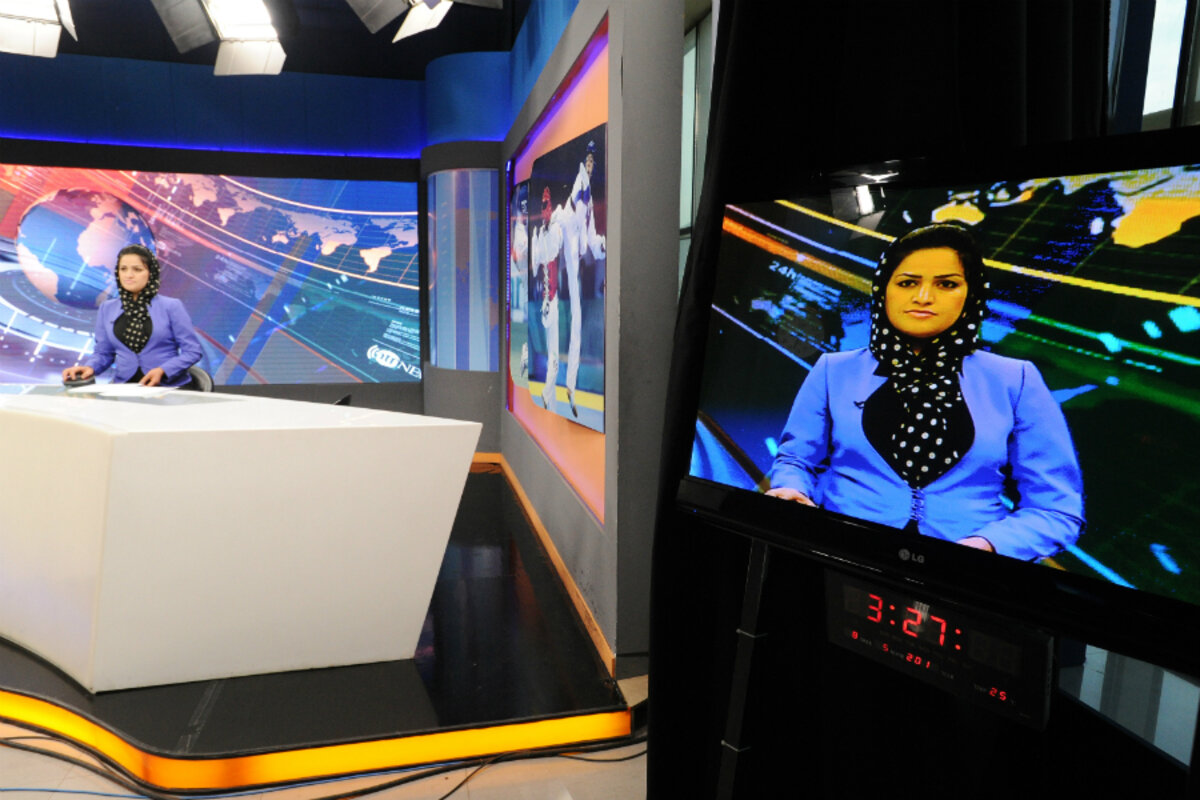Afghan journalists face threats from Taliban, officials, and even family
Loading...
| Kabul, Afghanistan
Wearing designer clothes and a headscarf, Afghan news anchor Fawzia Wahdat is on TV every day.
Almost as often, she receives phone calls – including one the morning of an interview with ���Ǵ��� – with threats to leave her job or risk more intimidation, kidnapping, or worse.
Ms. Wahdat, who is 27, was forced out of one job, she says, because of threatening letters that her bosses said jeopardized the entire TV station. And for weeks late last year she was followed daily by a car with two or three men. They stopped when her channel, Ariana TV, started sending a security detail with her.
“Leave your job, or we will eliminate you,” one recent caller warned. And another: “Always tell the truth, or we know what to do.”
Wahdat, who works in a fortified modern office building in Kabul – an airtight bubble in a sea of insecurity, says she cannot return to her native Jalalabad in the east because of the threats.
Yet coping with such threats has become part of a journalist’s job description in Afghanistan. Even as the news media have expanded and diversified in the 15 years since US forces ousted the Taliban, so too have the threats to journalists. They are now increasingly targeted by insurgents, by competing ethnic groups, and – especially for women – by angry, conservative family members who want them off the air and at home.
“The threat is not only to journalists, but it is for all people of Afghanistan,” Wahdat says. “I want to work for women, for the whole nation, to raise the lot of the Afghan people. Day by day, my ability [to do so] has become stronger.”
The dangers are not expected to ease, despite the killing Saturday of Taliban leader Mullah Akhtar Mansour in a US drone strike. President Obama, who authorized the strike in a remote region on the Pakistani side of the border, called the death “an important milestone,” even as senior Taliban members reportedly met to choose a new leader.
The price of journalists’ defiance can be high: Seven staff of Tolo TV were killed by a Taliban suicide bomber in January, after the Islamist militants declared that channel and another one a target, accusing them of “promoting the intellectual, cultural, and information [agenda] of the infidels” with the “complete backing of the Americans.”
When 15 Afghan news organizations condemned the Taliban immediately after the Tolo TV attack, the militants expanded their threat to all of them. That marks a significant and dangerous change from past years, when the Taliban took relative care not to target journalists.
“Before this, the Taliban, whenever a journalist was killed or injured in a suicide attack, immediately issued a press release saying this wasn’t meant for the journalist … because they wanted journalists to get their ‘facts’ out, too,” says Ilias Alami, operations manager for the Afghan Journalists Safety Committee (AJSC) in Kabul.
Bad press for Taliban
“But after the attack on Tolo TV, a lot of journalists don’t feel the same way. This has hurt the Taliban,” says Mr. Alami. “They are losing on the propaganda side. It’s very hard for them to gain the confidence of journalists again.”
Partially offsetting the increased threat to journalists from the Taliban is a decline so far this year in risks traced to government officials, Alami says.
As recently as January, the AJSC said in a report that government officials in 2015 were, “like in previous years, the leading cause of violence and intimidation against journalists.” The report noted government responsibility for 43 cases of attacks against journalists in 2015, compared with 19 by the Taliban and 11 from unknown groups.
The pattern now is being reversed.
“That’s a good sign,” says Alami, though he allows that: “The problem with violence from insurgent groups is there is no place where we can advocate for journalists’ safety, whereas with the government a lot of advocacy work in the past year has paid off.”
On May 3, President Ashraf Ghani marked World Press Freedom Day by noting recent laws to support the media, and by appointing a new ambassador-at-large for freedom of expression.
He called press freedom a “foundational pillar” for Afghan democracy, sent “blessings and prayers to the souls of the martyrs” of dead journalists, and commended their “brave and creative” work.
But bravery still remains a key attribute for Afghan journalists, whether working in a fortified Kabul office like Wahdat’s Ariana TV studio or smaller media outfits.
Mohammed Ala Babrak, for example, changes his route often before going live on different television channels as a commentator. The former journalist and media official, who started as a reporter with the mujahideen in the 1980s, says dangers to journalists today are unprecedented – and fanned by some channels owned by one ethnic group that criticizes others.
“Always I am telling the truth, and people don’t like the truth,” says Mr. Babrak, who phone has rung with calls “from many numbers,” threatening to kill him.
Pressure from family
Wahdat’s brother-in-law, in another example, whose ideas she says mirror the Taliban’s, complained when she posted a photo of herself on Facebook.
Wahdat replied with this public post: “My life belongs to me. My face belongs to me. No one can interfere.”
Her situation is far from unique among Afghanistan’s women journalists. Doniya Paktiani came from an illiterate family and fought for years to convince her father to let her be educated. The father – who she says believes Pashtun tribal law states that “women are only for the home, and for the grave” – finally relented, because the family was so poor.
Now the 22-year-old has done TV and radio jobs in Kabul, and dreams of elevating women’s lives through journalism. Ms. Paktiani’s younger brother was the most opposed, and once told her: “If you continue to do this job, I will kidnap you and kill you.”
But he has since left Afghanistan as part of the migrant exodus to Europe, giving Paktiani greater freedom: “Now my family is proud of me, my salary is good,” she says.
Nazifa Mahboubi knows how that pressure feels, too. The correspondent for US-funded Radio Azadi got her start in 2012 covering a suicide bombing for Tolo TV. Though she only appeared on camera that one time, a cousin later heard her voice on television, came to the office to take her away, and offered to pay her $1,000 each month if she would quit.
Ms. Mahboubi also worked on stories that drew unwanted attention. After a story about Taliban and sex with minors, she says she was threatened “many times” that she would be targeted.
Once her own editor warned her that she should “lower your head in the car” so it would not be shot at. On the eve of a story about personal prisons run by warlord-politicians, her phone rang. She was told: “If you broadcast this, tomorrow will be the last day of your life.”
“I will never leave the country,” says Mahboubi, despite the risks. She enjoys doing stories that raise awareness of women and justice issues. But her cousin has become her “big enemy,” she says.
“He called my mother and warned her, ‘Don’t let your son go very far; he will be shot because of your daughter.’ ”





